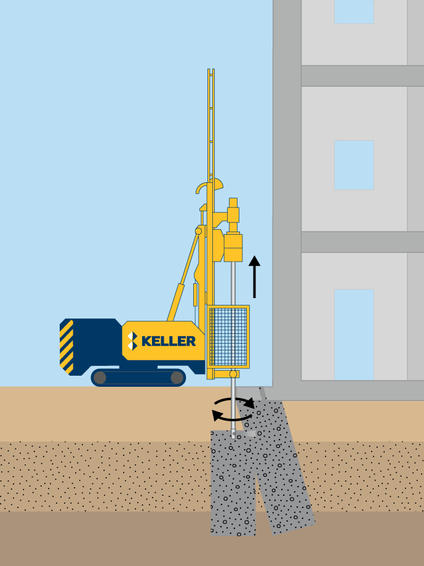Jet grouting uses high velocity fluid jets to construct cemented soil, or Soilcrete, of varying geometries in the ground.

Common uses
Process
Jet grouting creates in situ geometries of Soilcrete (grouted soil), using a grouting monitor attached to the end of a drill stem. The jet grout 'monitor', or injection tool, is advanced to the maximum treatment depth. Then high velocity jets (cement grout with optional water and air) are initiated from ports in the monitor. The jets erode and mix the in situ soil with grout as the drill stem and monitor are rotated and raised in a controlled and pre-determined manner.
Depending on the application and types of soils, one of three variations is used: the double fluid system (slurry grout jet surrounded by an air jet) and the less common single fluid system (slurry grout jet), and the triple fluid system (water jet surrounded by an air jet, with a separate grout port). The jet grouting process constructs Soilcrete panels, full columns, or partial columns with designed strength and/or permeability.
The Soilcrete geometry and physical properties are designed based on the in-situ soils. Because it is an erosion-based system, soil erodibility plays a major role in predicting geometry, quality, and production. Cohesionless soils are typically more erodible by jet grouting than cohesive soils.
Advantages
Quality assurance
With 40 years of experience, working across the globe, Keller has seen and completed more jet grouting projects than any other contractor in the world. Our robust design, testing procedures and experience provide us confidence in knowing when the technique can be used and also most importantly what the limits of application are.
Most projects will begin with a field validation component whereby a number of potentially sacrificial columns or less sensitive columns are installed and tested to demonstrate column diameters and anticipated early strengths are achieved.
The jet grouting process is a highly dynamic process. Instrumentation, monitoring and recording of the drilling and injection parameters is important. In addition, surface and structural monitoring of nearby sensitive structures is also typically undertaken.
We are constantly seeking to improve our technology. Recently we have developed Keller’s proprietary method of determining column diameter: the Acoustical Column Inspector or ACI, to ensure project requirements are met.